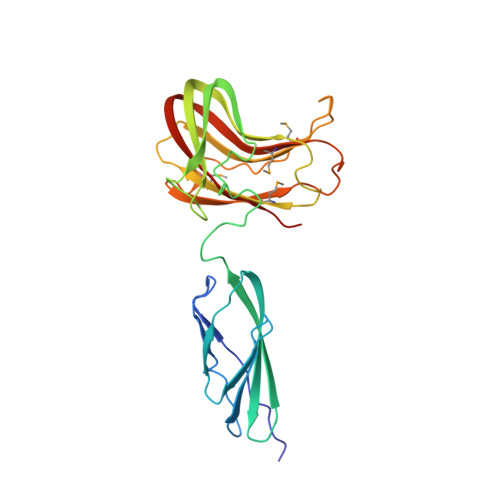Xyloglucan is Recognized by Carbohydrate-Binding Modules that Interact with Beta-Glucan Chains.
Najmudin, S., Guerreiro, C.I.P.D., Carvalho, A.L., Prates, J.A.M., Correia, M.A.S., Alves, V.D., Ferreira, L.M.A., Romao, M.J., Gilbert, H.J., Bolam, D.N., Fontes, C.M.G.A.(2006) J Biological Chem 281: 8815
- PubMed: 16314409
- DOI: https://doi.org/10.1074/jbc.M510559200
- Primary Citation of Related Structures:
2C24, 2C26, 2C4X - PubMed Abstract:
Enzyme systems that attack the plant cell wall contain noncatalytic carbohydrate-binding modules (CBMs) that mediate attachment to this composite structure and play a pivotal role in maximizing the hydrolytic process. Although xyloglucan, which includes a backbone of beta-1,4-glucan decorated primarily with xylose residues, is a key component of the plant cell wall, CBMs that bind to this polymer have not been identified. Here we showed that the C-terminal domain of the modular Clostridium thermocellum enzyme CtCel9D-Cel44A (formerly known as CelJ) comprises a novel CBM (designated CBM44) that binds with equal affinity to cellulose and xyloglucan. We also showed that accommodation of xyloglucan side chains is a general feature of CBMs that bind to single cellulose chains. The crystal structures of CBM44 and the other CBM (CBM30) in CtCel9D-Cel44A display a beta-sandwich fold. The concave face of both CBMs contains a hydrophobic platform comprising three tryptophan residues that can accommodate up to five glucose residues. The orientation of these aromatic residues is such that the bound ligand would adopt the twisted conformation displayed by cello-oligosaccharides in solution. Mutagenesis studies confirmed that the hydrophobic platform located on the concave face of both CBMs mediates ligand recognition. In contrast to other CBMs that bind to single polysaccharide chains, the polar residues in the binding cleft of CBM44 play only a minor role in ligand recognition. The mechanism by which these proteins are able to recognize linear and decorated beta-1,4-glucans is discussed based on the structures of CBM44 and the other CBMs that bind single cellulose chains.
- Requimte, Departamento de Química, FCT-UNL, 2829-516 Caparica, Portugal, CIISA-Faculdade de Medicina Veterinária, Universidade Técnica de Lisboa, Avenida da Universidade Técnica, 1300-477 Lisboa, Portugal.
Organizational Affiliation:



















